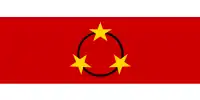1975 AIA building hostage crisis
The AIA Building hostage crisis took place at the AIA (American Insurance Associates) Building in Jalan Ampang, Kuala Lumpur, Malaysia on 5 August 1975.[1] The Japanese Red Army took more than 50 hostages at the AIA building, which housed several embassies. The hostages included the United States consul and the Swedish chargé d'affaires. The gunmen won the release of five imprisoned terrorists and flew with them to Libya.
Background
The Japanese Red Army was a communist terrorist organisation dedicated to eliminating the Japanese government and monarchy and launching a worldwide revolution. The organisation carried out many attacks and assassinations in the 1970s, including the Lod Airport massacre in Tel Aviv three years earlier.[2]
Attacks
The AIA Building in Jalan Ampang, Kuala Lumpur used to house the United States and Swedish embassies. On 4 August 1975, 5 members of the JRA stormed the building and took 53 employees of the embassies hostage. All the hostages were gathered on Level 9 of the AIA Building. The JRA demanded that several of their imprisoned leaders be released, and threatened to massacre all 53 hostages if their demands were not met.
The Malaysian Prime Minister at the time was Tun Abdul Razak and his police chief was Mohammed Hanif Omar. The then Home Minister Ghazali Shafie was heavily involved in negotiations despite his being in Jakarta at the time.[3]
Eventually, the Japanese government relented and agreed to the release of five JRA leaders. They were sent on a Japanese Airlines DC-8 to Kuala Lumpur. The Deputy Transport Minister Dato' Ramli Omar and secretary-general for the Home Ministry Tan Sri Osman Samsuddin Cassim were exchanged with the terrorists as hostages to guarantee safe conduct. The hostage-takers proceeded on the DC-8 with their freed leaders, as well as Omar and Cassim, to Libya, arriving at Tripoli Airport on 8 August after a stopover in Colombo. There they would be sheltered by dictator Muammar Gaddafi, who at the time supported a variety of terrorist organisations such as the PLO and the IRA.[4] Samsuddin Cassim and Ramli Omar returned to Malaysia unharmed on 10 August.
Hostages
- Robert C. Stebbins - United States Consul
- Fredrik Bergenstråhle - Swedish embassy Officer
- Ulla Odqvist - Secretary of the Embassy of Sweden
- Gerald Lancaster - US citizen - age 50
- Trudy Lancaster - Australian citizen - age 32
- Vick Lancaster - Australian citizen - age 11
- Rodney Lancaster - Australian citizen - age 10
- Adrian Lancaster - Australian citizen age 9
Aftermath
Among the prisoners freed by the Japanese government was Kunio Bandō, who had been jailed for his role in the Asama-Sanso incident. Bandō was later believed to have assisted in the hijacking of Japan Airlines Flight 472 from Paris to Tokyo in 1977, forcing the jet to land in Dhaka. Bandō remains at large and reportedly spent time between 1997 and 2007 in Russia, China, the Philippines, and Japan.[5]
The US embassy was moved to a new location at the junction of Jalan Ampang and Jalan Tun Razak in the 1990s.
Swedish King Carl XVI Gustaf awarded the Royal Order of the Polar Star to Tan Sri Samsudin Osman Kassim on 16 September 2009, about 34 years later. The award was presented by the Swedish ambassador to Malaysia, HE Helena Sångeland.
References
- VENGADESAN, M. S. (2020). MALAYSIAN MURDERS AND MYSTERIES: A century of shocking cases that gripped the nation. Place of publication not identified: MARSHALL CAVENDISH INTL.
- "Those named by Lebanese officials as having been arrested included at least three Red Army members who have been wanted for years by Japanese authorities, most notably Kōzō Okamoto, 49, the only member of the attacking group who survived the Lod Airport massacre." "Lebanon Seizes Japanese Radicals Sought in Terror Attacks", The New York Times, 19 February 1997.
- Tun Ghazali Sentiasa Ada Idea Baru - Musa Hitam Bernama. Accessed 1 July 2013. Archived 5 July 2013.
- Brian Lee Davis. Qaddafi, terrorism, and the origins of the U.S. attack on Libya. p. 182.
- Kyodo",Wanted radical Kunio Bando was in Philippines in 2000: sources", The Japan Times, "Death-row convict wins libel case", Schreiber, pp. 209–217.
External links
- "Terrorists Seize Embassies," Associated Press report in Los Angeles Times, 4 August 1975 (A library card may be needed to access this link.)



